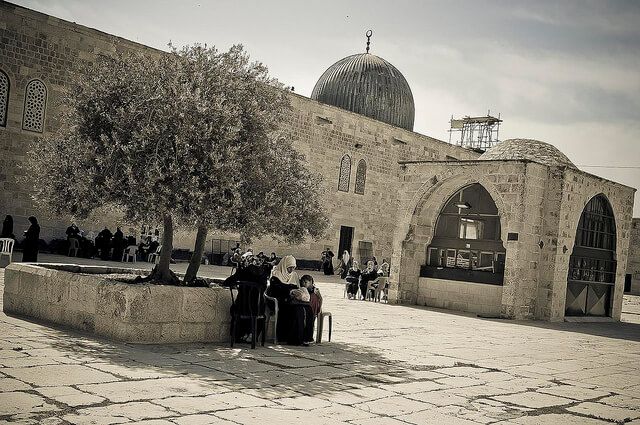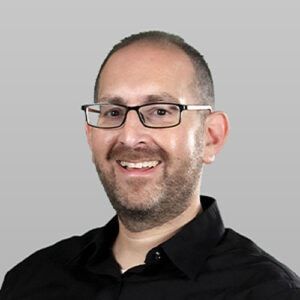The Los Angeles Times no longer has a permanent Jerusalem bureau chief. Which is why it relies on reports by, among others, Palestinian journalist Maher Abukhater, who is referred to as a “special correspondent” in two articles he has penned on recent disturbances on the Temple Mount. Both display a clear bias.
The first article, “20 Palestinians hurt in clashes with Israeli police at Al Aqsa holy site,” was published on September 13. Referring to the “Al Aqsa mosque compound,” the article states:
The violence occurred after Israeli police allowed Jewish worshipers and tourists to visit the hilltop compound in Jerusalem’s Old City, revered by Muslims as their third holiest site after Mecca and Medina and by Jews as the site of their ancient temple.
Having made it clear that the site is Islam’s third holiest, Abukhater fails to adequately state that the compound, also known as the Temple Mount, also happens to be the holiest site in Judaism.
Abukhater deliberately omits important context and misleads. The reference to “Jewish worshipers” visiting the compound incorrectly presumes that all of the Jewish visitors are there for the express purpose of praying on the Temple Mount, which is forbidden under the existing status quo agreement that governs the administration of the site. And by referring to “worshipers,” the article places the onus on those Jewish visitors as the cause of the violence, a theme that continues in subsequent paragraphs:
Palestinians were preparing to disrupt attempts by the Jewish visitors to hold prayers at the compound to mark the impending Jewish New Year, which began at sunset Sunday. Israeli policies allow Jews to visit the area outside the mosque during specific hours, but forbid them to pray there.
Police had recently shut down the mosque to Muslim worshipers, mainly women, during the Jewish visiting hours to prevent confrontations.
In fact, the LA Times completely ignores the reality on the Temple Mount over an extended period of time. Avi Issacharoff explains in the Times of Israel:
For many years, non-Muslims have been permitted to visit the Temple Mount during certain hours, in particular during the morning and for one hour during the afternoon.
However, in recent months there was an increase in the number of incidents in which Islamist women, mostly members of the now-outlawed Murabitat group, attacked non-Muslim visitors under the pretense of guarding the holy site.
As a result of this, the Jerusalem police began to block the entry of Muslim women during the hours that Jews and foreigners visited the Mount.
Abukhater would have you believe that it was Jews seeking to pray on the Temple Mount that have provoked confrontations and the latest round of violence. He would also have you believe that Muslim women have been prevented from praying in their mosque when it is actually those very women who have not been worshiping but attacking visiting groups.

In his second article, “Israeli police and Palestinians clash for a third day at holy site in Jerusalem,” published on September 15, Abukhater continues to give precedence to Muslim claims to the Temple Mount referring near the beginning of the article to the
holy site known to Muslims as Haram al Sharif, location of the historic Al Aqsa mosque and golden Dome of the Rock, and clashed with Palestinians holed up inside.
Only further in the article, Abukhater says simply that Jews “call the site Temple Mount and claim it as the location of their temples.” While Muslim claims are treated as fact, Jewish historical ties to the site are treated as unverified claims.
As for the violence on the Temple Mount itself, the article states:
The Palestinian Red Crescent said its medics treated more than 30 cases of people injured by beating or grenades, with few said to be serious.
Earlier in the piece, it refers to the use of stun grenades, which are non-lethal explosive device used to temporarily disorient an enemy’s senses. They are designed to produce a blinding flash of light and intensely loud noise “bang” of greater than 170 decibels (dB) without causing permanent injury.
So why now does the article refer to “grenades,” which are usually small bombs thrown by hand and potentially lethal. Let it be clear – Israeli police did not use such devices or anything other than non-lethal methods to deal with rioting Palestinians on the Temple Mount.
One cannot assume that someone reading this second article has already read the first article published two days prior. The second article contains even less context than the first and leaves a false impression that Israeli police are simply invading the Temple Mount compound in order to alter the existing status quo. The Israeli government has made it clear that it intends to uphold this status quo, something that the LA Times does not consider worthy of mention.
Maher Abukhater’s coverage of the Temple Mount disturbances raise serious question marks over the LA Times’s commitments to balanced and accurate reporting from Israel. If the newspaper is not to employ a permanent bureau chief then it should think very carefully before relying on the biased accounts of Maher Abukhater.
[sc:graybox ]Please contact the LA Times readers’ representative – http://www.latimes.com/about/la-contact-our-readers-rep-htmlstory.html – and let the LA Times know that its recent coverage is unacceptable.


